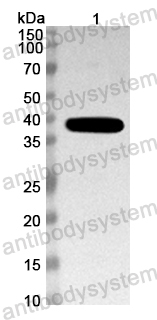Catalog No.
PMD29601
Species reactivity
Mouse
Host species
Rabbit
Isotype
IgG
Clonality
Polyclonal
Immunogen
E. coli - derived recombinant Mouse ADCYAP1 (Arg79-Arg171).
Tested applications
ELISA: 1:4000-1:8000, IHC: 1:50-1:100, WB: 1:1000-1:4000
Target
Pituitary adenylate cyclase-activating polypeptide, PACAP, PACAP-related peptide, PRP-48, Pituitary adenylate cyclase-activating polypeptide 27, PACAP-27, PACAP27, Pituitary adenylate cyclase-activating polypeptide 38, PACAP-38, PACAP38, Adcyap1, Pacap
Purification
Purified by antigen affinity column.
Accession
O70176
Applications
ELISA, IHC, WB
Form
Liquid
Storage buffer
0.01M PBS, pH 7.4, 50% Glycerol, 0.05% Proclin 300.
Stability and Storage
Use a manual defrost freezer and avoid repeated freeze thaw cycles. Store at 2 to 8°C for frequent use. Store at -20 to -80°C for twelve months from the date of receipt.
Effects of Cyclosporine A and Adalimumab on the expression profiles histaminergic system-associated genes and microRNAs regulating these genes in HaCaT cells., PMID:35899934
PACAP Induces Light Aversion in Mice by an Inheritable Mechanism Independent of CGRP., PMID:33846231
Distribution of pituitary adenylate cyclase-activating polypeptide 2 in zebrafish brain., PMID:29535004
High-resolution characterization of a PACAP-EGFP transgenic mouse model for mapping PACAP-expressing neurons., PMID:27197019
DNA methylation in human papillomavirus-infected cervical cells is elevated in high-grade squamous intraepithelial lesions and cancer., PMID:26768780
Methylation of Cervical Neoplastic Cells Infected With Human Papillomavirus 16., PMID:26552048
Galanin expression in the mouse major pelvic ganglia during explant culture and following cavernous nerve transection., PMID:22585545
Pituitary adenylyl cyclase activating polypeptide inhibits gli1 gene expression and proliferation in primary medulloblastoma derived tumorsphere cultures., PMID:21143927
PACAP-mediated sperm-cumulus cell interaction promotes fertilization., PMID:21071464
PACAP and its receptor VPAC1 regulate megakaryocyte maturation: therapeutic implications., PMID:18000164
Are multiple sclerosis and amyotrophic lateral sclerosis autoimmune disorders of endogenous vasoactive neuropeptides?, PMID:17582695
Glucagon-related peptides in the mouse retina and the effects of deprivation of form vision., PMID:16741711
PACAP regulation of secretion and proliferation of pure populations of gastric ECL cells., PMID:15968088
Pituitary adenylate cyclase-activating polypeptide prevents cell death in the spinal cord with traumatic injury., PMID:15913892
Effects of pituitary adenylate cyclase polypeptide (PACAP) on extinction of active avoidance learning in rats: involvement of neurotransmitters., PMID:15680470
Pituitary adenylate cyclase-activating polypeptide promotes differentiation of mouse neural stem cells into astrocytes., PMID:15620424
Opposite regulation of the mitochondrial apoptotic pathway by C2-ceramide and PACAP through a MAP-kinase-dependent mechanism in cerebellar granule cells., PMID:15569266
Neuronal morphological change of size-sieved stem cells induced by neurotrophic stimuli., PMID:15308290
Origin of PACAP-immunoreactive nerve fibers innervating the subarachnoidal blood vessels of the rat brain., PMID:15181370
Secretin: hypothalamic distribution and hypothesized neuroregulatory role in autism., PMID:15176437
The pituitary adenylate cyclase-activating polypeptide is a physiological inhibitor of platelet activation., PMID:15067323
Peripheral PACAP inhibits gastric acid secretion through somatostatin release in mice., PMID:15023860
Involvement of different receptors in pituitary adenylate cyclase activating polypeptide induced open field activity in rats., PMID:15003711
Steroidogenic factor-1 and the gonadotrope-specific element enhance basal and pituitary adenylate cyclase-activating polypeptide-stimulated transcription of the human glycoprotein hormone alpha-subunit gene in gonadotropes., PMID:12920232
Pituitary adenylate cyclase activating polypeptide and vasoactive intestinal peptide inhibit feeding in the chick brain by different mechanisms., PMID:12893417
Effect of anti-nerve growth factor treatment on pituitary adenylate cyclase activating polypeptide expression in adult sensory neurons exposed to adjuvant induced inflammation., PMID:12890505
Pituitary adenylate cyclase-activating polypeptide-immunoreactive nerve fibers in rat and human tooth pulps., PMID:12867270
Nociceptin immunoreactivity and receptor mRNA in the human trigeminal ganglion., PMID:12576178
Expression and distribution of pituitary adenylate cyclase-activating peptide in human prostate and prostate cancer tissues., PMID:12468104
Modulation of nociceptive transmission by pituitary adenylate cyclase activating polypeptide in the spinal cord of the mouse., PMID:12435456
PAC1 and PACAP expression, signaling, and effect on the growth of HCT8, human colonic tumor cells., PMID:12409223
A newly developed enzyme-immunoassay for measuring the tissue contents of PACAP in fish., PMID:12383861
Immunoreactive substance P is not part of the retinohypothalamic tract in the rat., PMID:12172789
Immunochemical characterization and measurement of neuronal type nitric oxide synthase in human neuroblastoma NB-OK-1 cell using novel anti-synthetic peptide antibody and specific immunoassay system., PMID:12047918
Inhibition of microglial CD40 expression by pituitary adenylate cyclase-activating polypeptide is mediated by interleukin-10., PMID:12020953
Expression of pituitary adenylate cyclase-activating polypeptide and PACAP type 1 receptor in the rat gastric and colonic myenteric neurons., PMID:11959368
Pituitary adenylate cyclase-activating polypeptide is a sympathoadrenal neurotransmitter involved in catecholamine regulation and glucohomeostasis., PMID:11756684
The photopigment melanopsin is exclusively present in pituitary adenylate cyclase-activating polypeptide-containing retinal ganglion cells of the retinohypothalamic tract., PMID:11756521
Light-dependent induction of cFos during subjective day and night in PACAP-containing ganglion cells of the retinohypothalamic tract., PMID:11669419
Pituitary adenylate cyclase-activating polypeptide inhibits collagen-induced arthritis: an experimental immunomodulatory therapy., PMID:11544304
Human gonadotropin-releasing hormone receptor gene transcription: up-regulation by 3',5'-cyclic adenosine monophosphate/protein kinase A pathway., PMID:11476937
Origin and Co-localization of nitric oxide synthase, CGRP, PACAP, and VIP in the cerebral circulation of the rat., PMID:11301497
Role of PACAP1 receptor in regulation of ECL cells and gastric acid secretion by pituitary adenylate cyclase activating peptide., PMID:11193828
Mice with markedly reduced PACAP (PAC(1)) receptor expression by targeted deletion of the signal peptide., PMID:11032869
Innervation of the rat pineal gland by PACAP-immunoreactive nerve fibers originating in the trigeminal ganglion: a degeneration study., PMID:10994782
Immunohistochemical localization of the VIP1 receptor (VPAC1R) in rat cerebral blood vessels: relation to PACAP and VIP containing nerves., PMID:10950381
Pituitary adenylate cyclase-activating polypeptide promotes the survival of basal forebrain cholinergic neurons in vitro and in vivo: comparison with effects of nerve growth factor., PMID:10947806
VIP and PACAP potentiation of nicotinic ACh-evoked currents in rat parasympathetic neurons is mediated by G-protein activation., PMID:10947803
A role of pituitary adenylate cyclase activating polypeptide (PACAP) as a regulator of paracrine interactions between folliculo-stellate cells and gonadotropes through the control of activin-follistatin interactions., PMID:10945291
Induction of pituitary adenylate cyclase-activating polypeptide mRNA in the medial parvocellular part of the paraventricular nucleus of rats following kainic-acid-induced seizure., PMID:10859494

